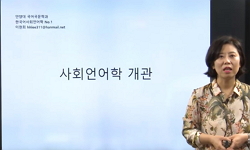This study seeks ways to promote S-S interaction by exploring students’ social presence in a college-level online learning community. The subjects of this study were 317 undergraduate students who attended a 15-week general English course, and they ...
http://chineseinput.net/에서 pinyin(병음)방식으로 중국어를 변환할 수 있습니다.
변환된 중국어를 복사하여 사용하시면 됩니다.
- 中文 을 입력하시려면 zhongwen을 입력하시고 space를누르시면됩니다.
- 北京 을 입력하시려면 beijing을 입력하시고 space를 누르시면 됩니다.

대학 수준의 온라인 학습환경에서 성별과 상호작용 방식에 따른 사회적 실재감 비교 연구 = A Comparison Study of Social Presence by Gender and Interaction Means in a College-level Online Learning Environment
한글로보기부가정보
다국어 초록 (Multilingual Abstract)
This study seeks ways to promote S-S interaction by exploring students’ social presence in a college-level online learning community. The subjects of this study were 317 undergraduate students who attended a 15-week general English course, and they were divided into asynchronous and synchronous interaction groups. This study adopted a mixed-method approach for data collection and analysis. A two-way analysis of variance (ANOVA) and an independent samples t-test analyzed quantitative data from the questionnaire adapting the social presence items in the Community of Inquiry Survey Instrument.
A categorization by open coding was performed on the open-ended items of the questionnaire and a written focus group interview. The results revealed that social presence by gender was not significantly different. However, there was a statistically significant difference in social presence when gender exchanged its effect with interaction means. Social presence by interaction means showed a statistically significant difference. Of the two, the group with frequent and good-quality interaction perceived higher social presence. The findings indicate social presence needs to be considered in the context of interaction means.
The formation of a sense of bond and intimacy in the online learning community was crucial in developing their social presence. The students’ perception of participation was closely related to S-S interaction in the online learning community.
This study concludes with a suggestion for instructors to facilitate students’ social presence and promote S-S interaction.
국문 초록 (Abstract)
이 연구의 목적은 대학 수준의 온라인 학습공동체에서 학습자의 사회적 실재감을 탐구하여 학습자간 상호작용을 촉진하는 방안을 모색하기 위함이다. 연구 대상은 15주간 교양영어 교과목...
이 연구의 목적은 대학 수준의 온라인 학습공동체에서 학습자의 사회적 실재감을 탐구하여 학습자간 상호작용을 촉진하는 방안을 모색하기 위함이다. 연구 대상은 15주간 교양영어 교과목을 수강한317명의 학부생으로, 이들은 비동기식 상호작용 집단과 동기식 상호작용 집단으로 구분되었다. 이 연구는자료의 수집과 분석에 혼합연구방법(mixed-method approach)을 채택하였다. 탐구공동체(Community of Inquiry, CoI) 설문조사 도구의 사회적 실재감 문항을 반영한 설문조사 결과에 대하여 이원배치분산분석(Two-way ANOVA)과 독립표본 t-검정(independent samples t-test)을 시행하였다. 설문조사의개방형 질문과 표본집단 서면 인터뷰는 개방 코딩방식의 범주화 작업을 통하여 분석하였다. 분석 결과에따르면, 첫째, 성별에 따른 사회적 실재감은 유의미한 차이를 보이지 않았으며, 성별은 상호작용 방식과함께 작용할 때 사회적 실재감에 유의미한 차이를 보였다. 둘째, 상호작용 방식에 따른 사회적 실재감은통계적으로 유의미한 차이를 보였다. 즉, 상호작용이 자주 일어나고 양질의 상호작용이 일어나는 집단에서 학습자의 사회적 실재감이 더 높았던 것으로 나타났다. 이는 상호작용 방식의 맥락에서 사회적실재감을 고려해야 함을 시사한다. 셋째, 온라인 학습공동체에서 학습자의 유대감과 친밀감 형성은사회적 실재감을 발달하도록 돕는 중요한 요소였으며, 학습 참여에 대한 학습자들의 인식은 학습공동체내의 학습자-학습자 상호작용과 밀접한 관련이 있었다. 이 연구는 학습자의 사회적 실재감을 촉진하고학습자 간의 상호작용을 도모하기 위한 교수자의 역할에 대한 제언으로 마무리한다.
참고문헌 (Reference)
1 이보경, "코로나 19로 인한 비대면 교양영어 수업의 학습자 반응에 관한 연구" 한국교양교육학회 14 (14): 97-112, 2020
2 권성연, "온라인 학습환경에서 사회적 실재감 하위요인이 지각된 토론효과에 미치는 영향" 한국교육정보미디어학회 22 (22): 1-29, 2016
3 조은미, "온라인 학습공동체에서 사회적 실재감이 학습몰입과 학습효과에 미치는 영향" 한국교육정보미디어학회 16 (16): 23-43, 2010
4 김광모, "사회적 실재감이 온라인 커뮤니티 지속사용의도에 미치는 영향" 한국콘텐츠학회 14 (14): 131-145, 2014
5 권성연, "사회적 실재감과 학습성과와의 관계에서 자기효능감, 정교화전략, 비판적 사고전략의 매개효과 분석" 학습자중심교과교육학회 15 (15): 1-27, 2015
6 Woods, R., "Using non-subject-matter-specific discussion boards to build connectedness in online learning" 17 (17): 99-118, 2003
7 Al-Dheleai, Y. M., "Using Facebook for the purpose of students' interaction and its correlation with students' academic performance" 16 (16): 170-178, 2017
8 Poon, J., "Use of blended learning to enhance the student learning experience and engagement in property education" 30 (30): 129-156, 2012
9 Kehrwald, B., "Understanding social presence in text-based online learning environments" 29 (29): 89-106, 2008
10 Kreijins, C. J., "Two pitfalls of social interaction in computer-supported learning environments and how to avoid them" 14 (14): 69-76, 1998
1 이보경, "코로나 19로 인한 비대면 교양영어 수업의 학습자 반응에 관한 연구" 한국교양교육학회 14 (14): 97-112, 2020
2 권성연, "온라인 학습환경에서 사회적 실재감 하위요인이 지각된 토론효과에 미치는 영향" 한국교육정보미디어학회 22 (22): 1-29, 2016
3 조은미, "온라인 학습공동체에서 사회적 실재감이 학습몰입과 학습효과에 미치는 영향" 한국교육정보미디어학회 16 (16): 23-43, 2010
4 김광모, "사회적 실재감이 온라인 커뮤니티 지속사용의도에 미치는 영향" 한국콘텐츠학회 14 (14): 131-145, 2014
5 권성연, "사회적 실재감과 학습성과와의 관계에서 자기효능감, 정교화전략, 비판적 사고전략의 매개효과 분석" 학습자중심교과교육학회 15 (15): 1-27, 2015
6 Woods, R., "Using non-subject-matter-specific discussion boards to build connectedness in online learning" 17 (17): 99-118, 2003
7 Al-Dheleai, Y. M., "Using Facebook for the purpose of students' interaction and its correlation with students' academic performance" 16 (16): 170-178, 2017
8 Poon, J., "Use of blended learning to enhance the student learning experience and engagement in property education" 30 (30): 129-156, 2012
9 Kehrwald, B., "Understanding social presence in text-based online learning environments" 29 (29): 89-106, 2008
10 Kreijins, C. J., "Two pitfalls of social interaction in computer-supported learning environments and how to avoid them" 14 (14): 69-76, 1998
11 Biocca, F., "Toward a more robust theory and measure of social presence : Review and suggested criteria" 12 (12): 456-480, 2003
12 Vygotsky, L. S., "Thought and Language" MIT Press 1962
13 Hiltz, S. R., "The virtual classroom: Learning without limits via computer networks" Intellect Books 1994
14 Short, J., "The social psychology of telecommunications" John Wiley & Sons 1976
15 Lee, S., "The relationships between higher order thinking skills, cognitive density, and social presence in online learning" 21 : 41-52, 2014
16 Tu, C., "The relationship of social presence and interaction in online classes" 16 (16): 131-150, 2002
17 Yılmaz, R., "The impact of interactive environment and metacognitive support on academic achievement and transactional distance in online learning" 55 (55): 95-122, 2017
18 Akyol, Z., "The development of a community of inquiry over time in an online course : Understanding the progression and integration of social, cognitive and teaching presence" 12 : 3-22, 2008
19 모수경, "The Relationships among the Presences of Community of Inquiry and the Perceptions of EFL College Students in Online Learning" 한국멀티미디어언어교육학회 20 (20): 11-35, 2017
20 Lim, Y., "Technology type, gender and social presence: An experimental study" 2004
21 Tannen, D., "Talking from 9 to 5: How women's and men's conversational styles affect who gets heard, who gets credit, and what gets done at work" ERIC 1994
22 Gunawardena, C. N., "Social presence as a predictor of satisfaction within a computer-mediated conferencing environment" 11 (11): 8-26, 1997
23 Oztok, M., "Social Presence and Online Learning: A Review of Research" 25 (25): 2011
24 Garrison, D. R., "Researching the community of inquiry framework : Review, issues, and future directions" 10 (10): 157-172, 2007
25 Chidambaram, L., "Relational development in computersupported groups" 20 (20): 143-165, 1996
26 Shea, P., "Reconceptualizing the community of inquiry framework : An exploratory analysis" 23 : 9-17, 2014
27 Joksimovic, S., "Psychological characteristics in cognitive presence of communities of inquiry : A linguistic analysis of online discussions" 22 : 1-10, 2014
28 Lee, J., "Patterns of interaction and participation in a large online course : Strategies for fostering sustainable discussion" 15 (15): 260-272, 2012
29 Garrison, D. R., "Online community of inquiry review : Social, Cognitive, and teaching presence issues" 11 (11): 61-72, 2007
30 Swan, K., "On the nature and development of social presence in online course discussions" 9 (9): 115-136, 2005
31 Kozan, K., "New exploratory and confirmatory factor analysis insights into the community of inquiry survey" 23 : 39-47, 2014
32 Shea, P., "Learning presence as a moderator in the community of inquiry model" 59 (59): 316-326, 2012
33 Rourke, L., "Learning in communities of inquiry : A review of the literature" 23 (23): 19-48, 2009
34 Baxter-Magolda, M., "Knowing and reasoning in college:Gender-related patterns in students' intellectual development" Jossey-Bass 1992
35 Walther, J. B., "Interpersonal effects in computer-mediated interaction : A relational perspective" 19 (19): 52-90, 1992
36 Akcaoglu, M., "Increasing social presence in online learning through small group discussions" 17 (17): 1-17, 2016
37 김민정, "Implementation of the Community of Inquiry Model for a Blended EFL Writing Course" 한국영어어문교육학회 22 (22): 85-114, 2016
38 Xie, K., "Impacts of role assignment and participation in asynchronous discussions in college-level online classes" 20 : 10-19, 2014
39 Garrison, D. R., "Handbook of Distance Education 1" 113-127, 2003
40 Savicki, V., "Gender, group composition, and task type in small task groups using computer-mediated communication" 12 (12): 549-565, 1996
41 Gefen, D., "Gender differences in the perception and use of e-mail : An extension to the technology acceptance model" 21 (21): 389-400, 1997
42 Thayalan, X., "Gender difference in social presence experienced in e-learning activities" 67 : 580-589, 2012
43 Stein, D. S., "From ‘Hello’ to higher-order thinking : The effect of coaching and feedback on online chats" 16 : 78-84, 2013
44 Archibald, D., "Fostering the development of cognitive presence: Initial findings using the community of inquiry survey instrument" 13 : 73-74, 2010
45 Garrison, D. R., "Exploring causal relationships among teaching, cognitive and social presence: Student perceptions of the community of inquiry framework" 13 (13): 31-36, 2010
46 Yu, T., "Examining reliability and validity of a Korean version of the community of inquiry instrument using exploratory and confirmatory factor analysis" 25 : 45-52, 2015
47 Arbaugh, J. B., "Does teaching presence exist in online MBA courses?" 9 (9): 9-21, 2006
48 Arbaugh, J. B., "Developing a community of inquiry instrument: Testing a measure of the community of inquiry framework using a multi-institutional sample" 11 (11): 133-136, 2008
49 Garrison, D. R., "Critical inquiry in a text-based environment: Computer conferencing in higher education" 2 (2): 87-105, 1999
50 Tutty, J. I., "Computer-mediated instruction : A comparison of online and face-to-face collaboration" 56 (56): 101-124, 2008
51 Wojahn, P. G., "Computer-mediated communication : The great equalizer between men and women?" 41 (41): 747-752, 1994
52 Veerman, A. L., "Collaborative learning through computer-mediated communication in academic education" 2001 : 625-632, 2001
53 Schellens, T., "Collaborative learning in asynchronous discussion groups : What about the impact on cognitive processing?" 21 (21): 957-975, 2005
54 Ocker, R. J., "Asynchronous computermediated communication versus face-to-face collaboration : Results on student learning, quality and satisfaction" 8 (8): 427-440, 1999
55 Anderson, T., "Assessing teaching presence in a computer conferencing context" 5 (5): 1-17, 2001
56 Pena-Shaff, J. B., "Analyzing student interactions and meaning construction in computer bulletin board discussions" 42 (42): 243-265, 2004
동일학술지(권/호) 다른 논문
-
대학의 창의성 교육과 학부생의 수강경험 연구 -포커스그룹 인터뷰(FGI)
- 한국교양교육학회
- 김지희
- 2021
- KCI등재
-
- 한국교양교육학회
- 신현정
- 2021
- KCI등재
-
과학소설 쓰기를 통해 배우는 과학소설의 서사적 추진력 -과학소설 쓰기의 디자인 씽킹
- 한국교양교육학회
- 손나경
- 2021
- KCI등재
-
대학 교양교육을 위한 비대면 음악비평 교육프로그램 개발 -음악과 언어와의 관계를 중심으로
- 한국교양교육학회
- 이보림
- 2021
- KCI등재
분석정보
인용정보 인용지수 설명보기
학술지 이력
| 연월일 | 이력구분 | 이력상세 | 등재구분 |
|---|---|---|---|
| 2022 | 평가예정 | 재인증평가 신청대상 (재인증) | |
| 2019-01-01 | 평가 | 등재학술지 유지 (계속평가) |  |
| 2016-01-01 | 평가 | 등재학술지 선정 (계속평가) |  |
| 2015-01-01 | 평가 | 등재후보학술지 유지 (계속평가) |  |
| 2013-01-01 | 평가 | 등재후보학술지 유지 (기타) |  |
| 2011-01-01 | 평가 | 등재후보학술지 선정 (신규평가) |  |
학술지 인용정보
| 기준연도 | WOS-KCI 통합IF(2년) | KCIF(2년) | KCIF(3년) |
|---|---|---|---|
| 2016 | 2.01 | 2.01 | 2.12 |
| KCIF(4년) | KCIF(5년) | 중심성지수(3년) | 즉시성지수 |
| 2.11 | 2.11 | 2.837 | 0.45 |





 KCI
KCI 스콜라
스콜라






